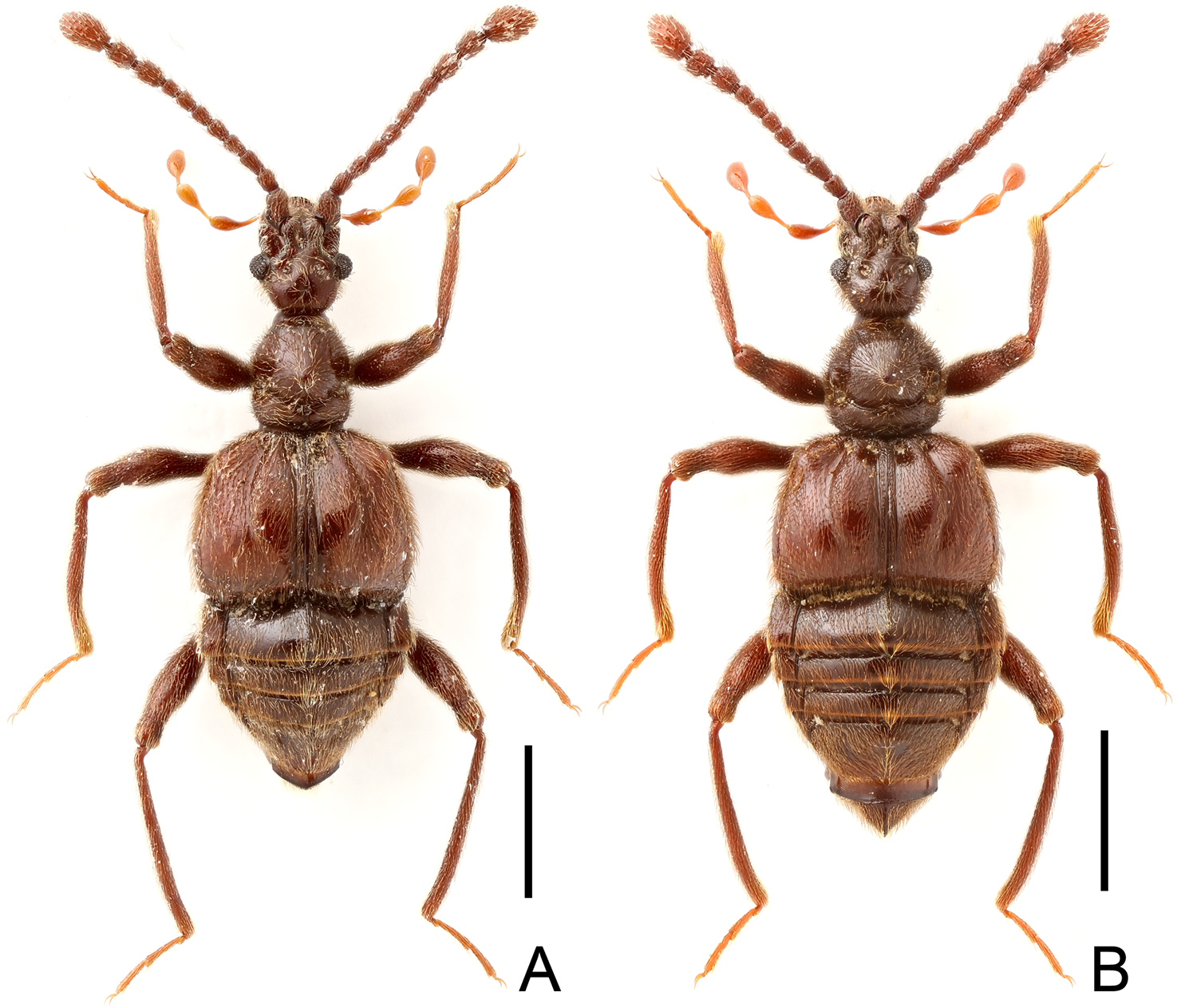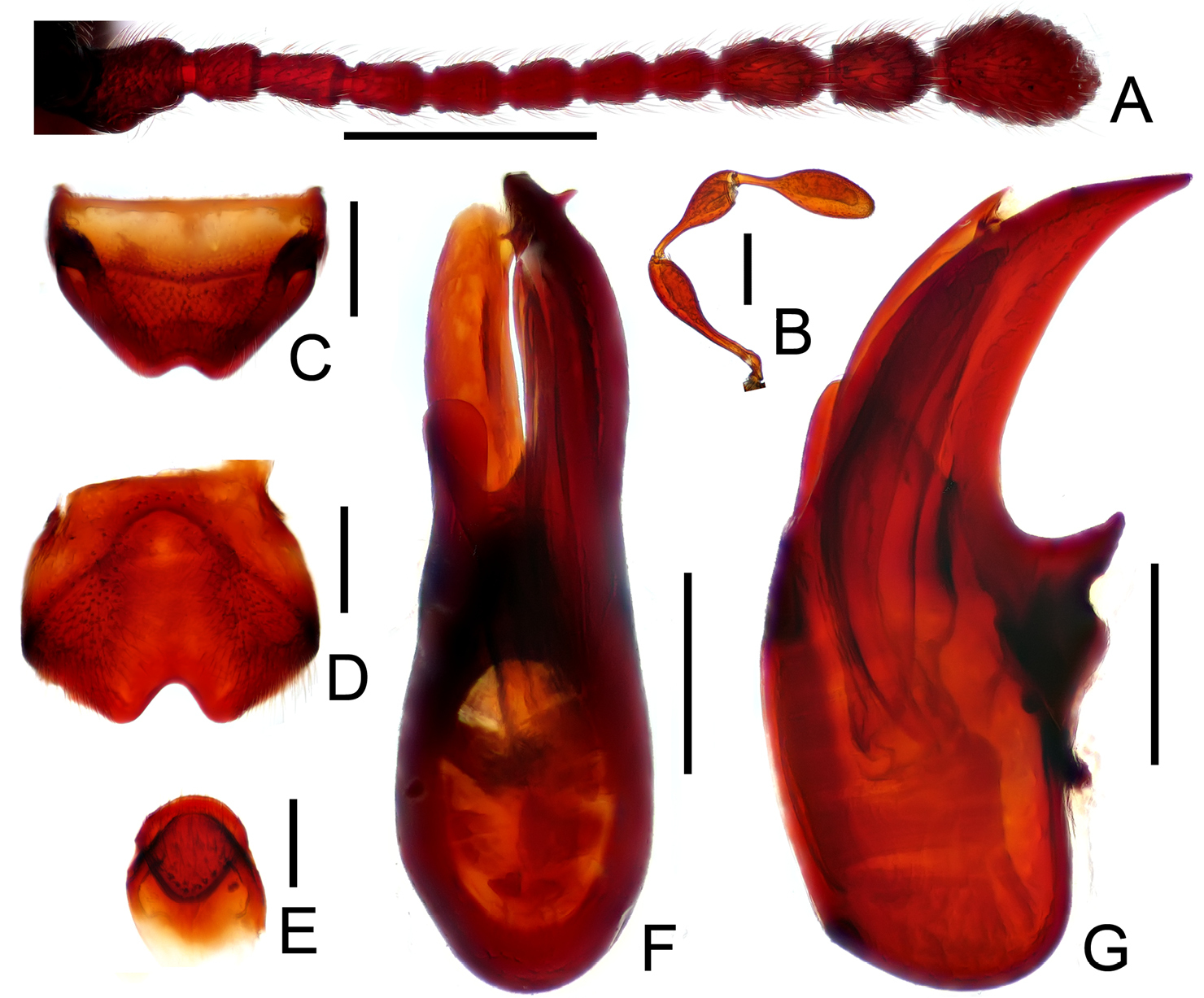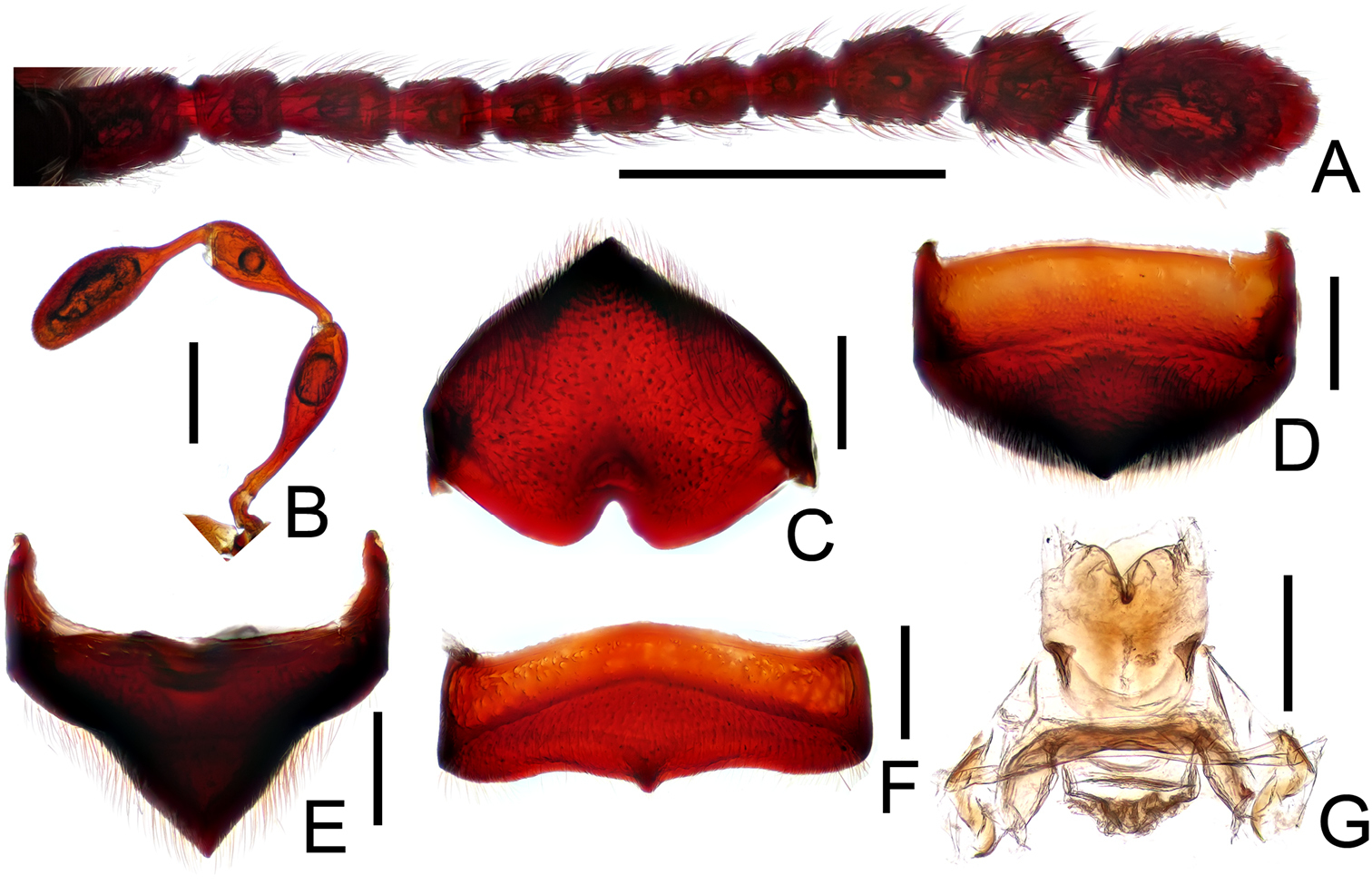






(C) 2013 Zi-Wei Yin. This is an open access article distributed under the terms of the Creative Commons Attribution License 3.0 (CC-BY), which permits unrestricted use, distribution, and reproduction in any medium, provided the original author and source are credited.
For reference, use of the paginated PDF or printed version of this article is recommended.
Two new species of the tyrine genus Megatyrus Hlaváč & Nomura, Megatyrus schuelkei Yin & Li, sp. n. (based on two males) and Megatyrus tengchongensis Yin & Li, sp. n. (based on one female), from Yunnan, Southwest China are described, illustrated and distinguished from allied species. The body size, form of maxillary palpi, male and female genital structures, and distributional patterns are used to separate the new species.
Staphylinidae, Pselaphinae, taxonomy, Megatyrus, new species, China
Members of Megatyrus Hlaváč & Nomura (type species: Megatyrus menglianensis Hlaváč & Nomura) are large (3.30–4.12 mm), rare pselaphine rove beetles inhabiting leaf litter of the forest floor. Six species have been described from South Asia: one from China, two from Vietnam (
The material treated in this study is housed in the following public institution and private collection:
SNUC Insect Collection of Shanghai Normal University, Shanghai, China (Zi-Wei Yin)
pcMS private collection of Michael Schülke, Berlin, German
The collection data of the referred material are quoted verbatim. A slash (/) is used to separate lines on the same label, and a double slash (//) is used to separate different labels. Authors’ notes are included in a ‘[]’. All type material bears the following label: ‘HOLOTYPE [red] or PARATYPE [yellow] / [genus name, species name] / sp. n., [authors of the species] / det. 2013. The depository is indicated after the collection data of the respective species.
All measurements are in millimeters. The following acronyms are applied: AL–length of the abdomen along the midline; AW–maximum width of the abdomen; BL–length of the body (= HL + PL + EL + AL); EL–length of the elytra along the sutural line; EW–maximum width of the elytra; HL–length of the head from the anterior clypeal margin to the occipital constriction; HW–width of the head across eyes; PL–length of the pronotum along the midline; PW–maximum width of the pronotum.
urn:lsid:zoobank.org:act:FCA38920-031F-4F09-8060-A455CB8927B1
http://species-id.net/wiki/Megatyrus_schuelkei
Figs 1A, 2(2 ♂♂). Holotype: ♂, labeled ‘CHINA: Yunnan, Lincang Pref., / Xue Shan, 48 km N Lincang, / 2070 m, 24°19'03"N, 100°07'13"E, / forest remnant, N-slope, litter & / mushrooms sifted, 12.IX.2009, / leg. M. Schülke [CH09-45]’ (pcMS). Paratype: 1 ♂, same label data as holotype (SNUC).
Male (Fig. 1A). Length 3.52–3.70 mm. Head longer than wide, HL 0.81–0.84 mm, HW 0.68–0.69 mm; eyes each composed of about 50 facets; maxillary palpi as in Fig. 2B; antennae (Fig. 2A) with scapes roundly projecting basolaterally; terminal three antennomeres enlarged. Pronotum longer than wide, PL 0.71–0.73 mm, PW 0.64–0.65 mm, lateral margins nearly parallel, evenly narrowed apically at basal 2/3. Elytra wider than long, EL 0.97–0.99 mm, EW 1.43–1.48 mm. Mesotrochanters, metatrochanters and metafemora lacking spine or projection at ventral margins. Abdomen broad at base and narrowed apically, AL 1.03–1.14 mm, AW 1.38–1.40 mm. Tergite VIII as in Fig. 2C; sternite VIII as in Fig. 2D; sternite IX as in 2E. Aedeagus length 0.83 mm, with elongate median lobe asymmetric (Figs 2F, G).
Female. Unknown.
Habitus of Megatyrus. A Megatyrus schuelkei, male B Megatyrus tengchongensis, female. Scales (mm): 1.0.
Diagnostic features of male Megatyrus schuelkei. A antenna B maxillary palpus C tergite VIII D sternite VIII E sternite IX F aedeagus, in dorsal view G same, in lateral view. Scales (mm): A = 0.5; B, C, D, F, G = 0.2; E = 0.1.
Megatyrus schuelkei is most similar to Megatyrus laqueus Hlaváč & Nomura from Vietnam in sharing similar body size and aedeagal structure. The two species can be clearly separated by the more elongate maxillary palpi, and the antennomeres VI–VIII are slightly more elongate in the new species. Megatyrus laqueus has shorter maxillary palpi and quadrate antennomeres VI–VIII. Megatyrus schuelkei can be separated from Megatyrus menglianensis by the more elongate pronotum, and different aedeagal structure.
Southwest China: Yunnan.
Individuals were collected from sifted leaf litter with mushrooms in a forest remnant.
The new species is named after Michael Schülke, collector of the type series.
urn:lsid:zoobank.org:act:989B0696-4F01-47B8-9279-DAE226D8D119
http://species-id.net/wiki/Megatyrus_tengchongensis
Figs 1B, 3(1 ♀). Holotype: ♀, labeled ‘CHINA: Yunnan [CH07-17] / Baoshan Pref., mountain range 25 km S / Tengchong, 1900 m, 24°48'28"N, 98°32'03"E, dev. primary decid. forest, / litter, fungi sifted, 2.V.2007, M. Schülke’ (pcMS).
Female (Fig. 1B). Length 3.71 mm. Head longer than wide, HL 0.79 mm, HW 0.65 mm; eyes each composed of about 35 facets; maxillary palpi as in Fig. 3B; antennae (Fig. 3A) with scapes simple; terminal three antennomeres enlarged. Pronotum slightly longer than wide, PL 0.74 mm, PW 0.71 mm, lateral margins nearly parallel, evenly narrowed apically at middle. Elytra wider than long, EL 0.93 mm, EW 1.43 mm. Legs simple. Abdomen broad at base and narrowed apically, AL 1.25 mm, AW 1.46 mm. Tergite VIII as in Fig. 3C–E; sternite VIII as in Fig. 3F. Genital complex weakly sclerotized, width 0.55 mm, with dorsal and ventral sclerites (Figs 3G).
Male. Unknown.
Diagnostic features of female Megatyrus tengchongensis. A antenna B maxillary palpus C tergite VIII, in posterior view D same, in dorso-posterior view E same, in dorsal view F sternite VIII G female genital complex, in dorsal view. Scales (mm): A = 0.5; B–G = 0.2.
In general, Megatyrus males are morphologically similar to females, and possess indistinct second sexual characters. Proportions of head, pronotum and abdomen between male and female are close, except that females have much shorter elytra, as well illustrated in
Southwest China: Yunnan.
The adult was collected from sifted leaf litter in a deciduous forest.
The new species is named after the type locality, Tengchong County.
Authors’ thanks go to Michael Schülke (Berlin) for kindly providing the material used in this study. Zi-Wei Yin thanks Shûhei Nomura (Tokyo) for his hospitality during the visit to the National Museum of Nature and Science, Japan in February 2012. Two anonymous reviewers are thanked for comments on an earlier draft. This study is supported by the National Science Foundation of China (No. 31172134) and Shanghai Normal University (Sk201242).


